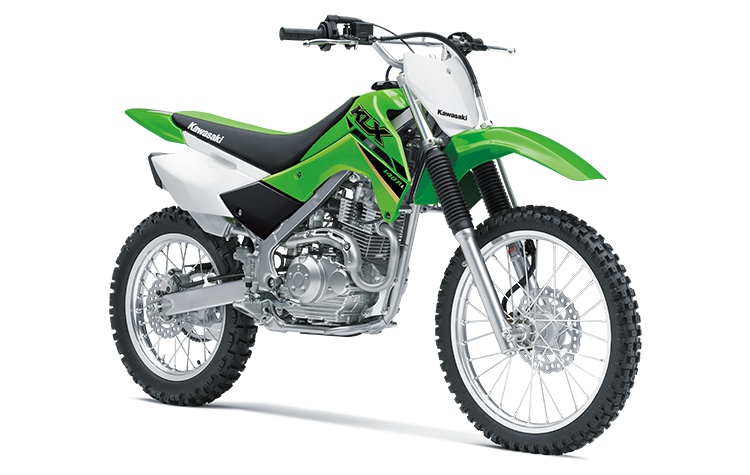2022 Kawasaki KLX140R L TROUBLESHOOTING GUIDE

TROUBLESHOOTING GUIDE
NOTE
This troubleshooting guide is not exhaustive and does not give every possible cause for each problem listed. It is meant simply as a quick guide to assist you in troubleshooting some of the more common difficulties.
Starting failure or difficulties
The starter motor does not rotate:
- Engine stop switch not position
- Starter lockout switch trouble
- Starter motor trouble
- Battery voltage low
- Starter relay not contacting or operating
- The starter button not contact
- Starter system wiring shorted or open
- Engine stop switch trouble
- Main fuse 10 A blown
The starter motor rotating but the engine does not turn over:
- Starter clutch trouble
- Starter idle gear trouble
The engine does not turn over:
- Valve seized
- Cylinder or piston seized
- Crankshaft seized
- Connecting rod small end seized
- Connecting rod big end seized
- Camshaft seized
- Transmission gear or bearing seized
Fuel does not flow:
- No fuel in the tank
- The fuel tap turned off
- Fuel tank cap air vent obstructed
- Fuel tap clogged
- Fuel line clogged
- Float valve clogged
Engine flooded:
- Fuel level too high
- The float valve is worn or stuck open
- Wrong starting technique
Spark missing or weak:
- The engine stop switch turned off
- Spark plug dirty, broken, or gap improperly adjusted
- Spark plug cap or high-tension wiring defective
- Spark plug cap not contacting properly
- Spark plug type incorrect
- Crankshaft sensor defective
- Igniter defective
- ignition coil defective
- Engine stop switch wiring defective
- Flywheel magneto damaged
- Wiring shorted or interrupted
Fuel/lair mixture incorrect:
- Idle adjusting screw improperly adjusted
- Pilot jet or air passage clogged
- Air cleaner element clogged, poorly sealed, or not installed
Compression low:
- Spark plug lose
- The cylinder head was insufficiently tightened
- Cylinder or piston worn
- No valve clearance
- Crankshaft oil seal leak
- Valve spring broken or weak
- Valve not seating properly (valve bent, worn, or
- carbon accumulation on the seating surface)
- Piston ring worn, weak, broken, or sticking
- Piston ring side clearance excessive
- Cylinder head gasket damaged
- Cylinder head warped
- Cylinder gasket damaged
Poor low-speed performance
Spark weak:
- Spark plug dirty, broken, or gap improperly adjusted
- Spark plug cap or high-tension wiring defective
- Spark plug cap shorted or not contacting properly
- Spark plug type incorrect
- Igniter defective
- Ignition coil defective
- Crankshaft sensor defective
- Flywheel magneto defective
- The wiring connector is not in good contact
Fuel/air mixture incorrect:
- idle adjusting screw improperly adjusted
- Pilot jet, needle jet, or air passage clogged
- Air cleaner element clogged, poorly sealed, or not installed
- Choke valve closed
- Carburetor fuel level too high or too low
- Fuel tank cap air vent obstructed
- Carburetor holder lose
- Air cleaner duct lose
- Fuel tap clogged
Compression low:
- Spark plug lose
- The cylinder head was insufficiently tightened
- Cylinder or piston worn
- No valve clearance
- Valve spring broken or weak
- Valve not seating properly (valve bent, worn, or carbon accumulation on the seating surface)
- Piston ring worn, weak, broken, or sticking
- Piston ring side clearance excessive
- Cylinder head gasket damaged
- Cylinder head warped
- Cylinder gasket damaged
- Decompression trouble
Other:
- Igniter defective
- Brake dragging
- Clutch slipping
- Engine overheating
- Engine oil level too high
- Engine oil viscosity too high
- Ignition timing incorrect
- Drive chain trouble
Poor or no high-speed performance
Firing incorrect:
- Spark plug dirty, broken, or gap improperly adjusted
- Spark plug cap or high-tension wiring defective
- Spark plug cap shorted or not contacting properly
- Spark plug type incorrect
- Igniter defective
- ignition coil defective
- Crankshaft sensor defective
- Flywheel magneto defective
- The wiring connector is not in good contact
Fuel/air mixture incorrect:
- The main jet is clogged or the wrong size
- Jet needle or needle jet worn
- Jet needle clip in the wrong position
- Carburetor fuel level too high or too low
- Air cleaner element clogged, poorly sealed, or not installed
- Choke valve closed
- Fuel contaminated with water or foreign matter
- Fuel tank cap air vent obstructed
- Carburetor holder lose
- Air cleaner duct lose
- Fuel tap clogged
- Fuel line clogged
- Needle jet or air passage clogged
Compression low:
- Spark plug lose
- The cylinder head was insufficiently tightened
- Cylinder or piston worn
- No valve clearance
- Valve spring broken or weak
- Valve not seating properly (valve bent, worn, or
- carbon accumulation on the seating surface)
- Piston ring worn, weak, broken, or sticking
- Piston ring side clearance excessive
- Cylinder head gasket damaged
- Cylinder head warped
- Cylinder gasket damaged
- Decompression trouble
Improper acceleration:
- Choke valve closed
- Carburetor fuel level too high or too low
- The main jet clogged
- The throttle Main valve does not fully open
- Air cleaner element clogged
- Muffler clogged
- Fuel contaminated with water or foreign matter
- Brake dragging
- Clutch slipping
- Engine overheating
- Engine oil level too high
- Engine oil viscosity too high
- Crankshaft bearing is worn or damaged
- Ignition timing incorrect
- Crankshaft sensor defective
Knocking
- Carbon built up in combustion chamber
- Fuel quality poor or type incorrect
- Spark plug type incorrect
- Igniter defective
Engine overheating
Firing incorrect:
- Spark plug dirty, broken, or gap improperly adjusted
- Spark plug type incorrect
- Igniter defective
Fuel/air mixture incorrect:
- The main jet is clogged or the wrong size
- Carburetor fuel level too low
- Carburetor holder lose
- Air cleaner element clogged, poorly sealed, or not installed
- The air cleaner duct is poorly sealed
Compression high:
- Carbon built up in combustion chamber
Engine overloaded:
- Brake dragging
- Clutch slipping
- Engine oil level too high
- Engine oil viscosity too high
- Drive chain trouble
Lubrication inadequate:
- Engine oil level too low
- Engine oil quality poor or type incorrect
- Clutch operation faulty-
Clutch slipping:
- No clutch lever play
- Clutch cable improperly adjusted
- Clutch cable defective
- Clutch plate worn or warped
- Clutch spring broken or weak
- Clutch release mechanism defective
- Clutch hub or housing unevenly worn
Clutch not disengaging properly:
- Clutch lever play excessively
- Clutch spring tension uneven
- Engine oil deteriorated
- Engine oil viscosity too high
- Engine oil level too high
- Clutch housing froze on drive shaft
- Clutch release mechanism defective
- Clutch hub nut loose
- Clutch plate warped or rough
- Clutch hub spline damaged
Gear shifting faulty
Transmission does not go into gear; shift pedal does not return:
- Clutch not disengaging
- Shift fork bent or seized
- Gear stuck on the shaft
- Shift mechanism arm spring broken
- Shift mechanism arm broken
- Shift return spring broken or weak
- Shift return spring pin lose
- Shift pawl broken
- Shift drum broken
Transmission jumps out of gear:
- Shirt Tork Worn
- Gear groove worn
- Gear dogs and/or dog grooves worn
- Shift drum groove worn
- Gear positioning lever spring broken or weak
- Shift fork pin worn
- Drive shart, output shart, and/or gear splines worn
Transmission skips gears:
- Gear positioning lever spring broken or weak
- Shift mechanism arm spring broken or weak
Engine noise abnormal
Knocking
- Carbon built up in combustion chamber
- Fuel quality poor or type incorrect
- Spark plug type incorrect
- Engine overheating
- igniter defective
Piston slap:
- Piston clearance excessive
- cylinder or piston worn
- Connecting rod bent
- Piston pin or piston pin holes worn
Valve noise:
Valve clearance incorrect
Valve spring broken or weak
Camshaft bearing or cam face worn
Other noise:
- Connecting rod small end clearance excessive
- Connecting rod big end clearance excessive
- Piston ring worn, broken, or stuck
- Piston seized or damaged
- Cylinder head gasket leaking
- Exhaust pipe leaking at the cylinder head
- Crankshaft runout excessive
- Engine mounts loose
- Crankshaft bearing worn
- Camshaft chain tensioner trouble
- Camshaft chain, sprocket, chain guide worn
- Flywheel magneto lose
Abnormal drive train noise
Clutch noise:
- Clutch housing/friction plate clearance excessive
- Clutch housing gear excessive
- Metal chip jammed in clutch housing gear teeth
Transmission noise:
- Crankcase bearing won or damaged
- Transmission gear is worn or chipped
- Metal chip jammed in gear teeth
- Engine oil level or viscosity too low
Drive chain noise:
- Drive chain slack improperly adjusted
- Drive chain worn
- Rear and/or engine sprocket(s) worn
- Drive chain inefficiently lubrified
- Rear wheel misaligned
- Frame noise abnormal
Front fork noise:
- Oil level or viscosity too low
- Spring broken or weak
Rear shock absorber noise:
- Shock absorber damaged
Disc brake noise:
- Pad installed incorrectly
- Pad surface glazed
- Brake disc warped
- Brake caliper defective
- Brake cylinder damaged
Other noise:
- Bracket, nut, bolt, etc. improperly mounted or tightened
Exhaust smoke
Excessively white:
- Piston oil ring worn
- Cylinder worn
- Valve oil seal damaged
- Valve guide worn
- Engine oil level too high
Black smoke:
- Air cleaner element clogged
- Main jet is too large or has fallen out
- Choke valve closed
- Carburetor fuel level too high
Brownish
- Main jet too small carburetor fuel level too low
- Air cleaner duct lose
- Air cleaner poorly sealed or missing
Poor handling and/or stability
Handlebar hard to turn:
- Cable, wiring incorrectly routed
- Steering stem nut too tight
- Screening stem Dearing damaged
- Steering stem bearing inadequately lubricated
- Steering stem bent
- Tire air pressure too low
Handlebar shakes or vibrates excessively:
- Tire worn
- Swingarm bushing damaged
- Rim warped or out of balance
- Front and/or rear axle runout excessive
- Wheel bearing worn
- Handlebar clamp lose
- Steering stem head nut lo0se
Handlebar pulls to one side:
- Frame bent
- Rear-wheel misaligned
- Warm bent or twisted
- Swingarm pivot shaft runout excessive
- Steering maladjusted
- Steering stem bent
- Front fork bent
- Right/left front fork oil level uneven
Shock absorption unsatisfactory (suspension too hard):
- Front fork oil excessive
- Front fork oil viscosity too high
- Front fork bent
- Tire air pressure too high
Shock absorption unsatisfactory (suspension too soft):
- Front fork oil level insufficient and/or front fork
- leaking oil
- Front fork oil viscosity too low
- Front fork and/or rear shock absorber spring weak
- Rear shock absorber leaking oil or gas
- Tire air pressure too low
Poor braking performance
- Air in the brake line
- Brake pad or disc wornBrake fluid leaking
- Brake disc warped
- Brake pads contaminated
- Brake fluid deteriorated
- Primary and/or secondary master cylinder cup(s) damaged
- Master cylinder scratched
- Brake maladjusted (lever or pedal play excessive)
Battery trouble
Battery discharged:
- Charge insufficient
- Battery faulty (too low terminal voltage)
- Battery cable making poor contact
- Flywheel magneto trouble
- Wiring faulty
- Regulator trouble
Battery overcharged :
- Flywheel magneto trouble
- Regulator trouble
- Battery faulty

